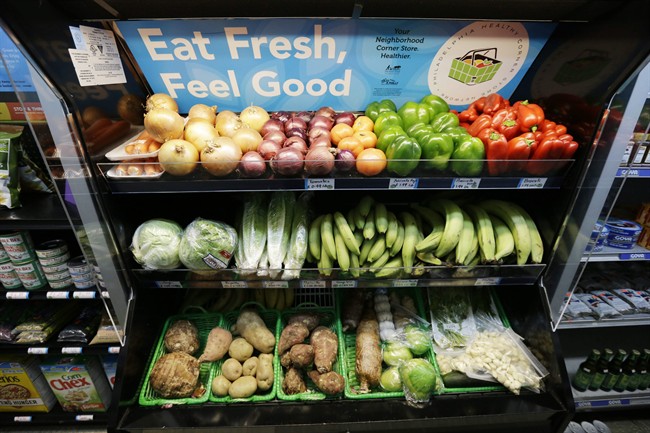TORONTO – With the loonie continuing to fall, the cost of groceries — especially fresh produce — is on the rise across Canada. The University of Guelph forecasts the price of vegetables will climb by 5.5 to 7.5 per cent throughout 2015, with fruits and nuts increasing by 3 to 5 per cent. That increase is putting a lot of pressure on families trying to stick to a healthy, balanced diet, that might not be able to afford it now. Here are five ways you can help save on your produce bill.

1. Grow your own
Growing your own produce is the best way to save money on your grocery bill if done right. Things like potatoes, tomatoes, lettuce, cucumbers and herbs are easy to grow and don’t require much effort. Even if you don’t have space in your yard for a garden or live in an apartment, you can easily grow certain items in containers, along the wall using pallets, and even inside old tires.
The key to saving money by growing your own produce is to not go overboard with your expectations. A small investment on some seed packs and already-started plants can yield big returns if you plan accordingly. If you can team up with neighbours to create a community garden you’ll have a greater investment-to-yield ratio.
READ MORE: Tips for novice gardeners – Start small, follow a plan, keep a journal, don’t get discouraged
Other easy veggies to grow include green beans, beets, carrots, radishes, and zucchini. Check with neighbours or local gardening groups to see what else they have had success growing in your area.
2. Can’t grow? Regrow!
If growing a garden from scratch is not your thing, regrowing items you buy elsewhere is a super easy way to cut back on produce expenses. This trick works best with green onions and lettuce, but can also be used on celery, onions, ginger root and even pineapples.
To test this method, the next time you use green onions add the base you usually throw away (that white part with the roots on it) into a small jar with some water. Leave it in an area that gets a lot of light. In a few days you’ll be amazed to see that you have a brand new batch of green onions that you can cut and use (you’ll be able to do this many times off of one base).
This same method applies to all the other items mentioned – place the base in water and leave in sunlight and they will regrow (some, like pineapples and celery, take longer than others).
3. Buy local
Buying produce from a local farm or farmers’ market is not only good for your region’s economy, but is also less expensive than going to the supermarket as you get items that are in season. The produce is also fresher, as it’s usually sold a day or two after it was harvested. The best deals at farmers’ markets can be found at the end of the day when they are closing up shop.
Find a farmers’ market in your region by visiting farmersmarketscanada.ca.
Joining a CSA, which stands for community-supported agriculture, is another good option for buying locally. Most CSAs are inexpensive to join and will keep you stocked with fresh produce for an entire season. The main downside is that you don’t have control over what items you get and will get a lot of one thing all at once. Research CSAs in your area and speak to other members to find one that suits your needs.
4. Don’t be scared of ‘imperfect’ fruits and veggies
Loblaw recently announced it will begin selling weird, small and misshapen fruits and vegetables under the “Naturally Imperfect” label at some stores in Ontario and Quebec, including Superstore, No Frills and Maxi. Items under this brand will sell for 30 per cent less than other produce and while they might be ugly, Loblaw promises the fruits and veggies will taste just as good.
WATCH BELOW: Global News reporter Cindy Pom looks at ways slightly misshappen produce can still be used in every day cooking.
Another way to save on produce that a lot of people overlook are the discount racks most grocery stores use to sell items that might be a little wilted or overly ripe. These racks offer a variety of fruits, vegetables, and even some canned goods at a much lower price and are a great option for same-day use, especially when making stews, soups, or baked goods. While bananas might cost 0.89 cents per pound in the aisle, you might be able to find an entire bunch (that are a little ripe) for 0.49 cents on the discount rack.
5. Plan your meals
Planning your meals in advance will not only save you money on produce, but all your other food requirements as well. Meal planning will also help you stick to a healthier diet and is one of the best ways to not waste food at home, as you will only be buying what you need (which, in turn, saves you money). With a meal plan in place it will also be easier to find deals on the items you need by checking prices — either with flyers or apps — before venturing out to the farmers’ market or grocery store.
READ MORE: How to have a successful litterless lunch plan
If you need help planning exciting lunches and dinners, there are many online resources available, such as $5 Dinners and Living Locurto.
SOUND OFF: Share your tips on how you save on produce in the comments below or on our Facebook page.





Comments